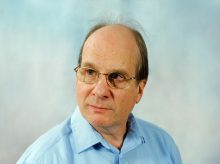2023 Nobel Prize in Chemistry is the 10th awarded for work conducted at Bell Labs
Louis E. Brus, a former Bell Labs researcher, was awarded the 2023 Nobel Prize in Chemistry on December 10, 2023 for “the discovery and synthesis of quantum dots.”
Brus shared the prize with Alexei Ekimov and Moungi Bawendi for the development of these nanoparticles so tiny that their size determines their properties. These smallest components of nanotechnology now spread their light from televisions, LED lamps and solar cells, and they can also guide surgeons when they remove tumor tissue, among many other uses in cell biology research, microscopy and medical imaging.
In its October 4 announcement, the Royal Swedish Academy of Sciences cited Brus for being “the first scientist in the world to prove size-dependent quantum effects in particles floating freely in a fluid.”
The award marked the 10th Nobel Prize awarded for work conducted at Bell Labs and the 2nd Nobel Prize in Chemistry.
Born in Cleveland, Brus attended Rice University in Texas on a U.S. Navy scholarship and was commissioned upon graduation. He was able to postpone his service to attend graduate school at Columbia University, where he received his PhD in physical chemistry in 1969.
After completing his military service, Brus joined Bell Labs in 1973 and worked there for 23 years on solid state physics, materials and microelectronics. It was during that time that he begun to be recognized as one of the leading nanoscience researchers for his work on colloidal nanocrystals. He continued his research at Bell Labs until 1996 when he joined the faculty in the Department of Chemistry at Columbia University, where he still is a professor emeritus and a special research scientist.
The key discovery came in 1983, when he noticed how the band gap of nanocrystals was larger than the bulk value of larger materials and changed with the particle size. His groundbreaking research on the creation of quantum dots generated a string of awards, now capped with the Nobel Prize.
In particular, the Nobel Committee for Chemistry cited Brus’ papers on a Simple Model for Quantum Size Effects and Quantum Size Effects in Nanoparticles.
In its announcement, the committee noted that this year’s laureates succeeded in producing particles so small that compared to a soccer ball each one of these “dots” was as small as the soccer ball itself was compared to Planet Earth.
Physicists had long known that in theory size-dependent quantum effects could arise in nanoparticles, but at that time it was almost impossible to sculpt in nanodimensions. Therefore, few people believed that this knowledge would be put to practical use.
Ekimov, Brus and Bawendi did.
Working in the USSR in the early 1980s, Ekimov succeeded in creating size-dependent quantum effects in colored glass. The color came from nanoparticles of copper chloride and Ekimov demonstrated that the particle size affected the color of the glass via quantum effects.
Unaware of Ekimov’s work, Brus later realized the same discovery at Bell Labs, but instead of using particles frozen in glass, he achieved it with nanoparticles in a liquid suspension and systematically proved the size dependent quantum effects.
Bawendi, who worked with Brus as a postdoc at Bell Labs, revolutionized the chemical production of quantum dots while at MIT a decade later. This resulted in almost perfect particles whose high quality was necessary to be utilized in practical applications.
The color of most light emitting materials depends on the type of material, but something strange happens when semiconductors shrink to nanoscale. When all three dimensions of the material are on the nanoscale, quantum physics effects change the color of light these materials absorb and emit. By modifying their size, light absorbers and emitters can be created at any color without having to change the type of material. Furthermore, because the color is tightly controlled by the nanoscale dimensions, they create ultra-pure colors that are great for high contrast displays or high-efficiency lasers and solar cells.
Quantum dots are now used in a very wide array of optoelectronic applications due to their high efficiency and ease of tuning. They illuminate computer monitors and television screens based on QLED technology. They also add nuance to the light of some LED lamps and biochemists and doctors use them to map biological tissue.
In terms of telecom applications, dot-based lasers are advantageous in terms of thermal behavior and optical feedback. They are advancing in maturity and offer higher gain, higher efficiency and better temperature stability than traditional laser materials. They are also key components for quantum optical communication due to their ability to create ultra-pure single photon pulses on demand. They could become not only the main laser technology for traditional communication networks but may also make up the critical components needed to create a quantum internet.
“The key thing is we believe that the real big applications are still in the future,” said Professor Heiner Linke, a member of the Nobel Committee for Chemistry. “Quantum dots can be seen as one milestone for the whole field of nanotechnology.”

 Contact aron
Contact aron RSS SUBSCRIBE
RSS SUBSCRIBE ALERT
ALERT